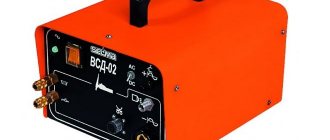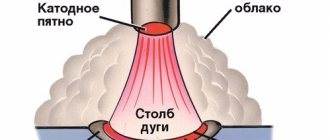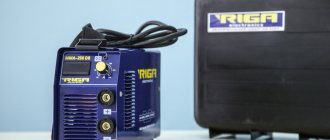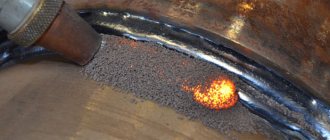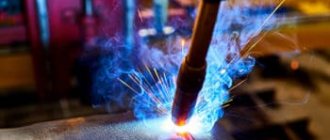The principle of electric arc welding is based on the use of the temperature of the electrical discharge that occurs between the welding electrode and the metal workpiece.
An arc discharge is formed due to electrical breakdown of the air gap. When this phenomenon occurs, gas molecules are ionized, its temperature and electrical conductivity increase, and it transitions to the plasma state.
The burning of a welding arc is accompanied by the release of a large amount of light and especially thermal energy, as a result of which the temperature rises sharply and local melting of the workpiece metal occurs. This is welding.
general description
An arc occurs between the electrode and the metal workpiece being worked with. The formation of this discharge occurs due to the fact that electrical breakdown of the air gap occurs. When such an effect occurs, gas molecules are ionized, not only its temperature increases, but also its electrical conductivity, and the gas itself turns into a plasma state. The welding process, or rather the burning of an arc, is accompanied by such effects as the release of large amounts of heat and light energy. It is precisely because of the sharp change in these two parameters towards their large increase that the process of metal melting occurs, since in a local place the temperature increases several times. The combination of all these actions is called welding.
Conditions of education
The main conditions for the formation of a welding arc are the following stages:
- Primary short circuit between electrode and product.
- The appearance of molten metal in the area between the electrode and the product.
- After the electrode is withdrawn, a pull out of the metal is formed - a “neck” is formed.
- The “neck” breaks with the formation of ionized gas.
- The appearance of a stable burning arc.
To maintain and stable combustion of the arc column, continuous ionization of the gas is necessary. For this purpose, either protective gases that have a high degree of ionization such as argon and helium are used.
If welding is performed using electrodes, then the composition of the coating includes additives from alkaline earth and alkali metals such as potassium, sodium and others. Due to this, there is an increase in ionization during combustion and melting of the electrode coating.
Arc Properties
In order for an arc to appear, it is necessary to briefly touch the workpiece with which you want to work with the electrode. Thus, a short circuit occurs, as a result of which a welding arc appears, its temperature rising quite quickly. After touching, it is necessary to break the contact and establish an air gap. This way you can select the required arc length for further work.
If the discharge is too short, it is possible that the electrode will stick to the material being processed. In this case, the melting of the metal will take place too quickly, and this will cause the formation of sagging, which is extremely undesirable. As for the characteristics of an arc that is too long, it is unstable in terms of combustion. In this case, the temperature of the welding arc in the welding zone will also not reach the required value. Quite often you can see a curved arc, as well as severe instability, when work is carried out with an industrial welding unit, especially if work is carried out on parts with large dimensions. This is often called magnetic blowing.
Requirements for welding seams
The requirements that may be placed on welding seams largely depend on the final purpose of the finished structure. Nevertheless, several general requirements can be identified that connections of this type must satisfy. The hardness and tensile strength of the welded joint must have the same indicators (or similar) as those of the base metal. Tests are carried out on special equipment with a sample of the finished product.
Visually check the quality of the seam as follows. After completing the welding work, the seams are cleaned of slag and oxides, and all auxiliary devices are also removed. The seam should be uniform, fine-scaled and have a uniform width. There should be no sagging, burns, narrowing or breaks. The metal that is deposited must be homogeneous and not have pores or surface cracks.
Magnetic blowing
The essence of this method is that the welding arc current is capable of creating a small magnetic field, which may well interact with the magnetic field that is created by the current flowing through the element being processed. In other words, the deflection of the arc occurs due to the fact that some magnetic forces appear. This process is called blowing because the deflection of the arc from the outside looks like it is due to strong wind. There are no real ways to get rid of this phenomenon. In order to minimize the influence of this effect, you can use a shortened arc, and the electrode itself must be located at a certain angle.
Arc structure
Currently, welding is a process that is discussed in sufficient detail. Thanks to this, it is known that there are three arc burning regions. Those areas that are adjacent to the anode and cathode are the anode and cathode sections, respectively. Naturally, the temperature of the welding arc during manual arc welding will also differ in these zones. There is a third section, which is located between the anode and cathode. This place is usually called the arc column. The temperature required to melt steel is approximately 1300-1500 degrees Celsius. The temperature of the welding arc column can reach 7000 degrees Celsius. Although it is fair to note here that it is not completely transferred to the metal, however, this value is enough to successfully melt the material.
There are several conditions that must be created to ensure a stable arc. A stable current with a strength of about 10 A is required. With this value, you can maintain a stable arc with a voltage from 15 to 40 V. It is worth noting that the current value of 10 A is the minimum, the maximum can reach 1000 A. The voltage distribution across areas is uneven and most of all it in the anode and cathode. Voltage drop also occurs in an arc discharge. After carrying out certain experiments, it was found that if welding is carried out with a consumable electrode, the greatest drop will be in the cathode zone. In this case, the temperature distribution in the welding arc also changes, and the greatest gradient occurs in the same area.
Knowing these features, it becomes clear why it is important to choose the correct polarity when welding. If you connect the electrode to the cathode, you can achieve the highest temperature of the welding arc.
Where is metal heated welding used and what equipment is needed?
The base material is most often subjected to preheating at a distance from the welded joint. Let's look at an example. A is a specific area of a fillet weld.
To calculate the distance from it to the place where preheating should be carried out, two problems will need to be solved:
- When the metal thickness is equal to or less than 50 mm, the calculated value should not be more than 50 mm from the welded joint.
- When the material thickness is more than 50 mm, the distance from the seam for preheating is taken to be less than 75 mm. This is indicated in the certification instructions for workers performing quality control of welded joints - CSWIP 23.4.
Today, manufacturers offer several types of different equipment for determining the control, indication and measurement of metal preheating temperature. It is used in a number of commercial industries.
Let's consider the main measuring instruments and temperature sensors used for this purpose:
- Contact thermometer – used to measure temperatures not exceeding +350 °C. The device is based on a “thermistor” - a temperature meter. The resistance of the latter decreases when heated, therefore, it is inversely proportional to temperature. The difficulty with this device is the “periodic calibration” that must be carried out to obtain accurate measurement results.
- Thermal pencil and thermal paste, which contain a material that changes color and melts under the influence of different heating temperatures. Their advantages are low cost and ease of use. The disadvantage is that the measurement result is not very accurate.
- Thermocouple. The principle used in this device is the calculation of the thermoelectric potential difference between the material being welded and the heated weld metal in order to calculate the temperature. The device should be used during and after welding, as well as for heat treatment. It continuously monitors cooling and heating temperatures over a wide range. However, it requires regular calibration, which is considered a rather big drawback.
Temperature zone
Regardless of the type of electrode used for welding, melting or non-consumable, the maximum temperature will be at the column of the welding arc, from 5000 to 7000 degrees Celsius.
The area with the lowest temperature of the welding arc shifts to one of its zones, the anodic or cathodic. These areas experience 60 to 70% of the maximum temperature.
AC Welding
Everything described above concerned the procedure for welding with direct current. However, alternating current can also be used for these purposes. As for the negative aspects, there is a noticeable deterioration in stability, as well as frequent jumps in the combustion temperature of the welding arc. One of the advantages is that you can use simpler, and therefore cheaper equipment. In addition, in the presence of a variable component, such an effect as magnetic blast practically disappears. The last difference is that there is no need to select polarity, since with alternating current the change occurs automatically with a frequency of about 50 times per second.
It can be added that when using manual equipment, in addition to the high temperature of the welding arc with the manual arc method, infrared and ultraviolet waves will be emitted. In this case, they are emitted by a discharge. This requires maximum protection for the worker.
Arc burning environment
Today, there are several different technologies that can be used during welding. They all differ in their properties, parameters and welding arc temperature. What methods are there?
- Open method. In this case, the discharge is burned in the atmosphere.
- Closed method. During combustion, a fairly high temperature is formed, causing a strong release of gases due to the combustion of flux. This flux is contained in the coating, which is used to process welding parts.
- Method using protective volatile substances. In this case, gas is supplied to the welding zone, which is usually presented in the form of argon, helium or carbon dioxide.
The presence of such a method is justified by the fact that it helps to avoid active oxidation of the material, which can occur during welding when the metal is exposed to oxygen. It is worth adding that, to some extent, the temperature distribution in the welding arc occurs in such a way that a maximum value is created in the central part, creating a small microclimate of its own. In this case, a small area with increased pressure is formed. Such an area can in some way impede the flow of air.
Using flux allows you to get rid of oxygen in the welding area even more effectively. If you use gases for protection, this defect can be eliminated almost completely.
Application area
Suitable for all types of arc welding such as:
- Manual (piece electrodes, non-consumable electrode in argon or other inert gases).
- Mechanized and semi-automatic methods in an environment of inert, active gases, under a layer of flux, as well as using specialized flux-cored wires.
- Automatic methods (plasma, under a layer of flux, robotic using active and inert gases, etc.).
- Plasma spraying.
- Plasma and arc cutting of metal.
- Air arc gouging.
- Renovation of surfaces.
Classification by duration
There is a classification of welding arc discharges according to their duration. Some processes are carried out when the arc is in a mode such as pulsed. Such devices weld in short bursts. For a short period of time, while flashing occurs, the temperature of the welding arc manages to increase to such a value that is enough to produce local melting of the metal. Welding occurs very precisely and only in the place where the device touches the workpiece.
However, the vast majority of welding equipment uses a long-lasting welding arc. During this process, the electrode continuously moves along those edges that need to be connected.
There are areas called weld pools. In such areas, the arc temperature is significantly increased, and it follows the electrode. After the electrode passes the area, the weld pool leaves after it, which is why the area begins to cool quite quickly. When cooled, a process called crystallization occurs. As a result, a weld seam occurs.
Safety precautions
Welding work is one of the most dangerous . High temperatures; bright light that has a negative effect on the eyes; fumes from both the metal and the electrode, damaging the lungs.
To prevent harm to health, you should follow safety rules.
The question “How to weld metal correctly” also includes precautions for the welder.
- Work in special clothing. The metal spattering of some electrodes reaches large values. Metal also often leaks out of the bathtub. All this leads to burns in the welder. Overalls include: leggings, welder's suit, hat (sparks fall on the head), leather boots, mask.
- If welding work is carried out indoors, do not forget to ventilate it. It must be dry, since humidity leads to dampening of consumables and also negatively affects the welding equipment. For example, the inverter often fails due to condensation, and the burner hoses become damp. In addition, working in a smoky room is often accompanied by headaches. Stale air saturated with gases can lead to lung cancer.
- The welder's mask must not have any damage to the filter. Otherwise, after a few minutes of work, your eyes will begin to “sore.” And after a few hours they will turn red and the eyelids will swell. Over time, this can lead to vision problems. Not much pleasant.
- To weld metal correctly, you need to maintain a distance from the place of welding to gas cylinders.
- Remove flammable and explosive objects as far as possible.
- Oxygen cylinders MUST NOT come into contact with oil. Otherwise, an explosion may occur.
- Electrical equipment for welding must be grounded.
These are just the basics that will prevent a welder from risking injury.
Arc elasticity
During welding, it is necessary to monitor the length of the arc very closely also because such a parameter as elasticity depends on it. In order to obtain a high-quality and durable weld as a result, it is necessary that the arc burns stably and uninterruptedly. The elasticity of the welded arc is a characteristic that describes the uninterrupted combustion. Sufficient elasticity is visible if it is possible to maintain stability of the welding process while increasing the length of the arc itself. The elasticity of the welding arc is directly proportional to such characteristics as the current used for welding.
What affects the power of the electric arc
If we consider the formula for arc power - Qef = ηIUd, we can conclude that it is influenced (determined) by arc voltage and current, as well as the welding method itself. Because depending on the method, the arc efficiency – η – changes.
Its value for manual welding ranges from 0.5 to 0.85, for welding in shielding gases it ranges from 0.6-0.7. For submerged arc welding, the coefficient value is from 0.8 to 0.92.
The power of the electric arc affects the speed of the process. It characterizes the amount of heat introduced into the product. The more heat input, the more productive the process can be. Simple logic: the more power, the faster you can weld.
